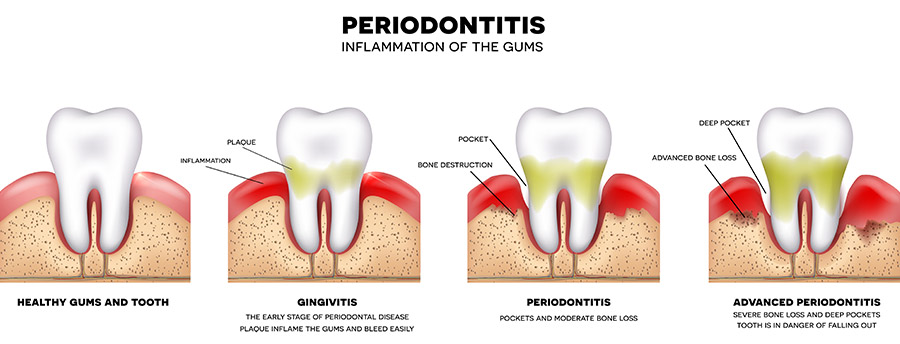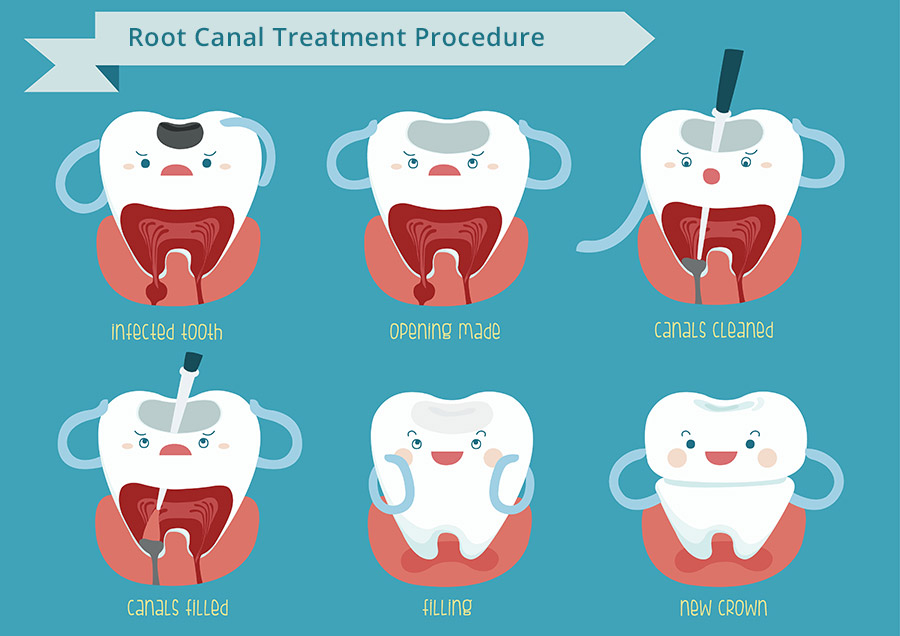Periodontal treatments and procedures
Periodontists are dental specialists who treat periodontal diseases in both surgical and nonsurgical manner. They also specialize in replacing missing teeth and dental implants.
- Non-Surgical Treatments
- Gum Graft Surgery
- Laser Treatment
- Regenerative Procedures
- Dental Crown Lengthening
- Dental Implants
- Pocket Reduction Procedures
Gum (Periodontal) Disease
Periodontal(gum) diseases infection of the tissues surrounding the tooth, caused by an accumulation of dental plaque, dental calculus, and bacteria, often due to poor oral hygiene. The first stage is gingivitis, or inflammation of the gum, characterized by redness and swelling, bleeding and tenderness. If left untreated, it can develop into periodontitis, where the gums recede leading to loosening of the teeth, bone loss and eventually, teeth loss.
Proper oral hygiene minimizes the risks of developing gum disease.

Treating Gum Disease
Gum disease treatment involves the removal of the dental plaque deposits alongside any other food remains trapped inside the dental pockets. This can be done using different methods, most common of which are scaling and curettage.
In severe cases, a periodontal abscess might develop which has to be properly cleaned and drained. In cases where there’s a severe loss of gum tissue, gum graft surgery is performed in an effort to prevent teeth loss.
Endodontic (Root Canal) treatment and procedure
Root canal treatment
When a tooth decay isn’t treated for prolonged periods of time, it spreads to the pulp of the tooth – the soft tissue containing blood vessels and nerves. In these cases, root canal treatment is required in order to save the affected tooth. The procedure is performed under local anesthesia and might require multiple visits to the dentist.

Root canal indications
Signs that indicate the need for a root canal treatment are:
- Prolonged sensitivity to heat or cold (particularly heat)
- Spontaneous, severe toothache
- Swelling of the gum around the affected tooth
- A toothache or tenderness when biting or chewing
- Discoloration of the tooth
Root canal treatment procedure
Under local anesthesia, the tooth is drilled and cleaned from decay. Once the pulp chamber is accessed, the dentist will carefully remove the infected dental pulp, devitalize the nerves and clean the root canals.
If the procedure requires multiple visits, the dentist will put a temporary filling in place in order to protect the tooth between visits. Afterward, the empty pulp chamber and root canals are filled with permanent filling and sealed. Pulpless(‘dead’) teeth are more brittle and prone to fractures.
To prevent this, placing an artificial dental crown is recommended. Proper dental hygiene is paramount to protect the treated tooth from decay and dental caries as it is desensitized to pain.
Frequently Asked Questions about General Dentistry
Gum disease
A periodontist is a dental specialist with expertise in treating gum disease. He/She has completed an extensive additional training in diagnosing, managing and treating gum disease. Unlike general dentist, he is qualified in performing complex periodontal treatments, such as:
- In-depth scaling & root preparation, (bacteria of the infected surface are cleaned)
- Root surface debridement (damaged tissue is removed).
- Regenerative Periodontal Surgery
If you suffer from an advanced form of gingivitis or periodontitis, a general dentist will refer you to a periodontal specialist.
There is no cure for gum disease, but the disease can be successfully managed to reduce or even prevent further damage. The initial periodontal treatment aims to remove the calculus (tartar) from the pockets below the gum line (root surface debridement). A local anesthetic is applied to reduce any discomfort during the treatment.
If you have a more aggressive form of gum disease you may also benefit from a short course of antibiotics alongside your treatment. In some cases, where the prognosis for the tooth is extremely poor, it might require an extraction. An extraction may be a suitable option if the affected tooth is very loose. We will also instruct you on the best methods to clean your teeth and gums, as the treatment will be more effective with adequate oral hygiene
If teeth are left untreated, the pockets may deepen and the bone loss can occur. This may lead to loosening of the teeth, repeated gum infections, and eventual loss of teeth. After a periodontal treatment, your gums will heal and become healthier, which goes a long way in keeping your teeth longer. The results will depend on your oral hygiene and original condition. You may also notice your breath feeling much fresher.
There is a strong indication of correlation between your gum health and general health. For example, there is strong evidence suggesting that periodontitis can adversely affect diabetes, and may increase the risk of future heart (cardiovascular) diseases. Therefore, managing gum disease may also help with the management of other concurrent health conditions.
You may notice a bad breath or your gums bleeding while brushing or flossing your teeth. Your gums may have receded, making your teeth look longer which can lead to temperature sensitivity. In some cases, your teeth might feel loose as the periodontal support tissues recede.
Root canal
Root canal treatment is necessary to deal with the infection of the dental pulp. Your tooth is made up of: the outer enamel, a hard layer called dentine and a soft tissue at the center known as pulp. The pulp consists of nerves, blood vessels, and soft tissue. When your tooth is growing, the pulp nourishes the root.
If the infection is left untreated, you risk losing your tooth. Root canal treatment is recommended when you experience excruciating pain or swelling, or if your dentist discovers any damage or infection after either examining an x-ray of your teeth.
The aim of the treatment is to remove the infection from the root canal of the affected tooth. The root is then cleaned and filled to prevent further infection.
Root canal treatment is a skill-intensive and time-consuming procedure and the treatment involves two or more visits to the dentist.
At the first appointment, the infected pulp is removed and any abscesses are drained. The root canal is then cleaned and prepared for the filling. A temporary filling is put in and the tooth is left to settle. At a later visit, when all of the infection has been cleared, the tooth is permanently filled.
In the past, a root-filled tooth would often darken after treatment. However, with modern techniques, this does not usually happen. If there is any discolouration, there are several treatments that will restore the natural appearance.
The alternative is to extract the tooth. Once the pulp is destroyed it can’t heal, and it is not recommended to leave an infected tooth in the mouth.
Although some people would prefer to have the tooth extracted it is usually best to keep as many natural teeth as possible.
Root canal procedures have a reputation for being painful. Contrary to popular belief, with modern local anesthetics and a skilled specialist endodontist, the patients report that treatment itself is no more uncomfortable than an ordinary tooth filling. There may be some tenderness afterward – which lessens over time
Teeth treated with root canal require normal and adequate oral hygiene. See your dentist for regular follow-up check-ups.

